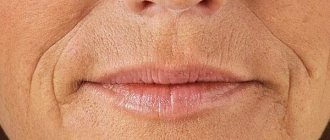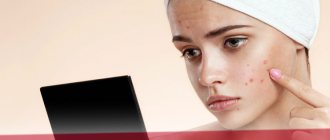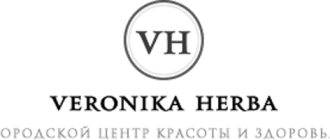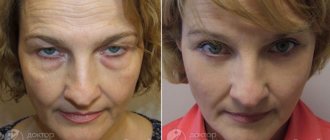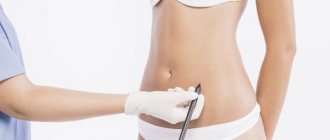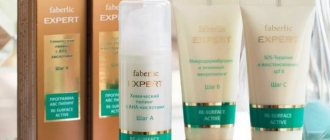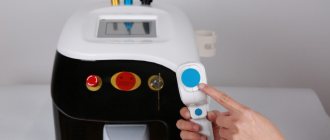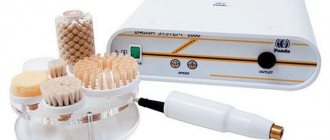How does a chemical peel work?
During deep chemical peeling, all regeneration processes are actively stimulated and the upper layers of the epidermis are removed, which ultimately leads to an improvement in the condition of facial skin without surgical intervention. Chemical peeling is a radical procedure, so it is usually done only if there are serious problems: acne, oily problem skin, demodicosis, wrinkles and scars . In addition, chemical peeling is successfully used to prevent skin aging and correct age-related cosmetic defects, eliminate hyperpigmentation, and keratomas .
Reviews
Here are some people's reviews of chemical peels:
SVETLANA, 34 YEARS OLD:
“Even in my youth I encountered acne.
I tried different remedies, but they didn’t help me, I started squeezing my acne, which led to scars. I dreamed of a beautiful face that would have a good aesthetic appearance, so I decided to undergo chemical peeling. At first the skin became very red, but the redness disappeared within 3 weeks.
The face became smooth, scars decreased. I will still visit a cosmetologist for the procedure.”
ALICE, 35 YEARS OLD:
“I regularly go for this procedure.
A cosmetologist recommended a retinol type to me. The face became amazing. Of course, the side effects are confusing when the skin peels and turns red. But they are short-term, which can be tolerated.”
NATALIA, 41 YEARS OLD:
“I have done salicylic chemical peels many times.
For the first time, the procedure scared me, as my face turned very red and crusts appeared. But the next time the side effects were not so striking. I look 10 years younger, men compliment me. At 40 I felt young.”
Indications for chemical peeling
Let's immediately figure out what age-related indications may be for chemical peeling:
- up to 25 years: treatment of problem skin, acne, acne vulgaris, prevention and treatment of molluscum contagiosum;
- 25-30 years: problematic skin, consequences of previous acne, treatment of actinic dermatitis and hyperpigmentation, prevention of skin aging.
- 30 years or more: treatment of hyperpigmentation of various etiologies, keratosis, correction and prevention of cosmetic skin defects (wrinkles, folds, aging skin), human papillovirus infection, preparation for skin plastic surgery and deep dermabrasion.
Types of chemical peeling. Skin types and chemical peeling
There are several types of chemical peels. They are classified depending on the power of the acid’s effect on the skin of the face:
- Superficial peeling (the process affects only the upper stratum corneum). This group includes retinoic, almond, glycolic and pyruvic peels. They are used to correct shallow wrinkles and age spots, as well as to prevent their occurrence. Peeling perfectly fights biological and photoaging of the skin. To enhance the effect of a superficial peel, it is often combined with deeper types of peels.
- Medium peeling . This category includes TCA peels based on trichloroacetic acid and combination Jessner peels. They act on the epidermal layer of skin affected by deep scars or wrinkles. An important advantage of this peeling is the ability to use it even at a young age.
- Deep peeling is the most radical type of peeling, because in this case the effect of the drugs affects the entire epidermis, not excluding the basement membrane. This category includes phenol peeling, which provides excellent results after complete healing of the skin.
In general, peeling can be performed on any skin type, but it is useful for you to immediately understand the characteristics of skin types.
- Type 1 – there are no wrinkles, the patient needs three peels with weak acids once a year to prevent skin aging.
- Type 2 – facial wrinkles in the corners of the eyes in a relaxed state and deep wrinkles during emotions, the presence of local foci of hyperpigmentation. Sevenfold peeling with fruit acids is required. It is advisable to conduct the course twice a year.
- Type 3 – the presence of wrinkles around the mouth, eyes, on the forehead in a relaxed state, pigmentation disorders. It is necessary to regularly carry out chemical peeling with fruit acids. In addition, you need to discuss with a specialist the possibility of peeling with trichloroacetic acid.
- Type 4 – multiple deep wrinkles and unevenness on the entire surface of the facial skin, pigmentation disorders. It is necessary to carry out three peelings with trichloroacetic acid, and subsequently additional peelings with glycolic acid under the guidance of a dermatocosmetologist.
The best results after chemical peeling are achieved by patients with skin types 2 and 3 . However, even with the fourth skin type, the result of chemical peeling can be very noticeable and quite satisfactory, especially if the patient realistically evaluates the expected results and brings his appearance into line with his internal state, and does not strive to look twenty again. Now we will introduce you to the procedure for chemical peeling.
Question answer
There are many methods in cosmetology to get rid of freckles, one of which is chemical peeling. Often it is necessary to conduct a course that includes 3-4 sessions. There should be 7-10 days between procedures.
Peels are often done on the face, décolleté and neck. But it can be done in other places.
It all depends on the depth of impact. For example, superficial peeling is allowed to be done once every 7 days. For the desired effect, it is recommended to carry out 4-5 sessions. Medium peeling can be performed no more than once every 6 months. But experts generally advise deep cleaning to be done once in a lifetime.
Chemical peel procedure and results
- A cosmetologist takes a cotton applicator soaked in a chemical solution and squeezes it thoroughly . This is done to ensure that the solution does not accidentally get into your eyes.
- Then, for 30 minutes to an hour, the doctor rubs the solution into the skin of your face with a cotton applicator. The duration of the entire procedure depends on the change in skin color. The doctor treats the skin starting from the forehead, then the nose, cheeks and chin. The solution is rubbed into wrinkles especially carefully. During the process, the patient usually feels a slight burning sensation. After the treatment is completed, the skin swells greatly within an hour and the patient will not be able to open his eyes for the first two days.
- Along certain lines, the doctor applies two layers of cotton and two layers of silk adhesive plaster to the face . Only four layers. This is necessary so that the skin retains a certain concentration of the solution for the required period. As a result, the entire procedure takes from one to two hours. You cannot remove the mask for two days; on the second day it will fall off almost on its own.
On the same day when the doctor removes the mask, the skin will be treated with thymol iodide, which promotes skin regeneration . You need to wear this mask for 7 days. After 7 days, the swelling will decrease significantly, and the skin of the face will be covered with a dense crust. Under no circumstances should you remove crusts yourself! This can lead to the formation of scars and scars!- Then the doctor covers the face with a thick layer of cotton wool for a day , after which the cotton wool is removed. All. From now on, the patient can take care of his facial skin himself using cosmetic products recommended by the doctor. Cosmetics containing glycolic acid should be avoided. On sunny days, use products with a UV filter with a protection level of at least 30.
Why is it better to have the procedure done by a cosmetologist, and how often should it be done?
Salon facial peeling - removal of dead keratinized epidermal cells from the surface of the face. But an incorrect procedure can lead to irreversible consequences:
- facial burn;
- mechanical damage to the skin;
- Too frequent, intensive procedures have the opposite effect - they accelerate aging.
You should entrust the youth and natural beauty of your skin to professionals - a cosmetologist or dermatologist with an excellent reputation and good experience.
There are many cleansing procedures, each of which can effectively solve one or more problems; professional help is required to understand them and achieve effect.
Only a specialist can choose a peeling:
- by skin type (dry, oily, combination);
- take into account its characteristics (age, general condition);
- solve problems (wrinkles, pigmentation, dull color, dryness).
Only a specialist can calculate the course of procedures and choose a cleansing method after a personal examination of the patient.
Without experience, it will be very difficult to understand all the intricacies of cleaning yourself; every mistake will be reflected (literally) on your face.
Is it worth taking such risks and experimenting with your appearance?
Chemical peel results
The result of the chemical peeling procedure will be rejuvenation of the skin and its renewed velvety appearance. During the peeling process, the skin is toned and regenerated, small wrinkles are eliminated, deep wrinkles and age spots are visibly reduced, and the skin texture is evened out. In the photos below you can see the amazing results of chemical peeling.
Video: chemical peeling procedure
WHO IS SUITABLE AND WHO IS NOT?
An analysis of the pros and cons of chemical facial peeling would be incomplete without a general list of indications and contraindications. With its help, you can evaluate the benefits of the method for yourself personally.
We recommend: 7 REASONS TO CONSIDER PEELING HARMFUL
Who is it recommended for?
The procedure is prescribed in the following cases:
- Dull complexion;
- Lumpy skin structure;
- Dark spots;
- Acne and post-acne;
- Photo- and chronoaging;
- Excessive dryness or oiliness of the skin;
- Cuperosis (with some exceptions).
It must be taken into account that only a qualified dermatologist can make a competent decision about the advisability of using certain chemical exfoliants for a particular patient.
When not to do a chemical peel
As a rule, it is recommended to refrain from chemical exfoliation for dark-skinned patients, as well as pregnant and lactating women. There are some restrictions for those taking retinoids or suffering from high blood pressure.
In addition, chemical exposure is prohibited for 2 weeks after visiting a solarium or with a fresh tan, as well as in places with fresh wounds, scratches and pimples with a white purulent core.
Contraindications for chemical peeling. Side effects
The chemical peeling procedure is contraindicated:
- in the presence of any neoplasms;
- in the presence of warts;
- in the presence of visible damage and irritation of the skin;
- with an active form of herpes;
- increased skin sensitivity;
- in case of allergic reactions to the drugs used;
- with a tendency to form keloid scars;
- during acne exacerbation;
- after recent radiotherapy;
- after recent use of the drug Roaccutane.
The most favorable season for chemical peeling is considered to be autumn , since during this period the sun is much less active, and the skin of the face is no longer so affected by direct ultraviolet rays. Chemical peeling is destructive to the skin and it takes time to recover, and direct exposure to ultraviolet radiation can greatly interfere with the regeneration process.
Prices for chemical facial peeling in Moscow and St. Petersburg
Moscow:
- Enzyme facial peeling - from 120 to 6500 rubles
- Glycolic facial peeling - from 110 to 7800 rubles
- Yellow facial peeling – from 1,500 to 20,500 rubles
- TCA peeling - from 1000 to 20,000 rubles
- Phenol facial peeling - from 4,000 to 50,000 rubles
- Jessner peeling - from 1000 to 12000 rubles
- AVR peeling - from 400 to 7000 rubles
- ANA peeling - from 250 to 7000 rubles
Saint Petersburg:
- Glycolic, salicylic, milk, almond, Jessner peeling from 1000 rubles
- Yellow (retinoic) peeling 3000 - 11000 rubles
- Peeling with TCA (trichloroacetic acid) 3000 rubles
- Yellow retinol 3800 rubles
- Hollywood 4000 rubles
- Yellow peeling express 2 days 11,000 rubles
- Alfa Beta - retinol 2200 rubles
- Glycolic from 500 to 1500 rubles
- Premium 4000 rubles
- Rezorpilovy 3600 rubles
- Almond 2300 rubles
